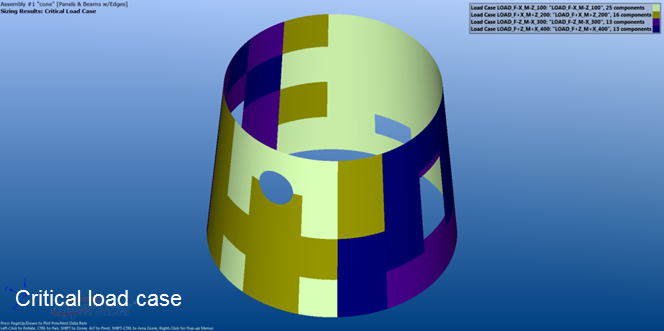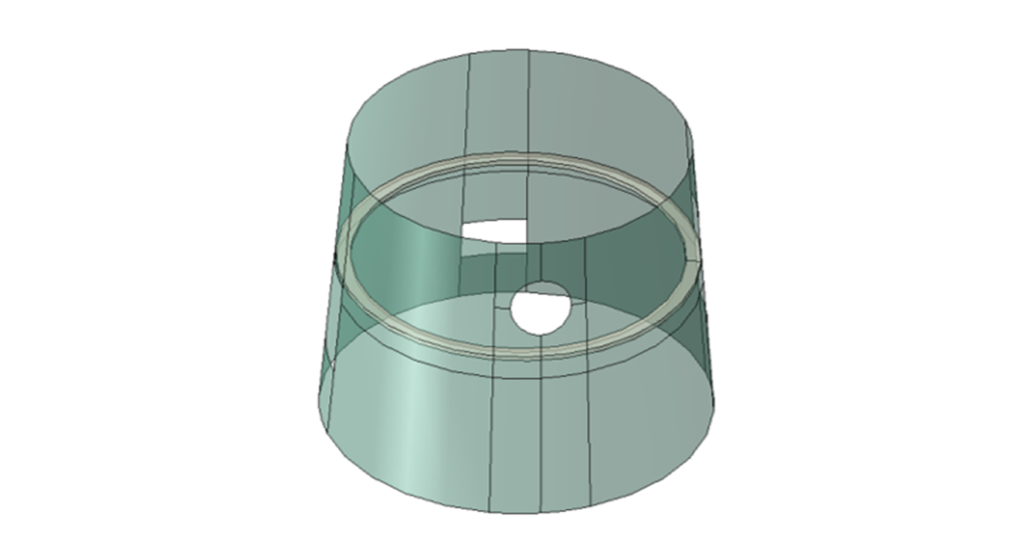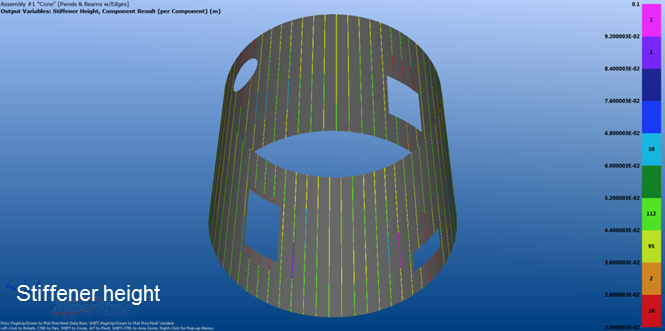
18 Feb Optimización de tamaño hecha por elementos finitos para la construcción de paneles reforzados
HyperSizer Pro es un software para la industria aeroespacial, destinado al análisis detallado de tensiones y a la optimización de tamaño estructural. El objetivo de este post es explorar las posibilidades de HyperSizer Pro para optimizar una estructura aeroespacial metálica típica. En este ejemplo en particular, se optimizará un modelo multietapa (interstage structure) simplificado.
Descarga la presentación completa: Optimización de tamaño con HyperSizer Pro.
Debido a la cantidad de vocabulario técnico de este post, se ha redactado en inglés. Si hubiera cualquier duda, contactar en el correo contacto@4realsim.com
Optimal Stiffened Panel
The optimal stiffened panel construction is shown below in a VCollab model. Click on the 3 dots in the top right and select Full Screen. Click on the arrows in the middle bottom to navigate in the report.
Interstage structure
From the performance, operational, interface and design requirements, it is concluded that recurring cost and buckling failure modes are the main design drivers of the interstage along with the lowest possible mass. The proposed concept for the interstage is based on a stiffened shell construction with ring-frames.
Simulation model
The simplified stiffened panel construction (see below) consists of an aluminum cone and aluminum ring frame, connected to each other with an infinitely stiff bond. The construction has been modeled with Abaqus, and contains 6 analysis steps: a frequency study, 4 simplified static load cases with concentrated forces and moments and a buckling study. The (optimal) simulation results are shared inside the html file attached to the bottom of this post. The html file is generated with VCollab.

Optimization problem
Stiffeners are placed in axial direction on the stiffened panel construction. During the optimization, the location of the stiffeners, the number of stiffeners, the dimensions of the stiffeners and the thickness of the skin will be varied. The amount of ring frames and the dimension of the ring frames are not considered as variables.
The requirements of the stiffened panel construction are the following
- The lowest possible mass
- The first eigenfrequency should be higher than 100 Hz
- The Mises stress for the 4 load cases should not be above 450 MPa
- The first buckling eigenvalue should be higher than 0 (preloading is used in the buckling procedure)
Parametric optimization
A possible solution to optimize this structure could be a process automation and design optimization solution, like for example Isight. The biggest advantage of this kind of solution would be that there is total freedom in the parameters and the outputs.
On the other hand, there are also some drawbacks.
- First, the number of parameters should remain as low as possible, as they have a direct effect on the duration of the optimization. This solution will take the Abaqus solver in the loop, which can increase the calculation time drastically.
- Secondly, a parametric script should be made to include the number of stiffeners and place them in the panel construction.
The workflow has been created, and 7 parameters have been varied to identify the lightest possible configuration that satisfies all constraints:
- Number of stringers – between 3 and 11
- Length of flange of all L shaped stiffeners
- Length of web of all L shaped stiffeners
- Thickness of the aft cone
- Thickness of the forward cone
- Flange thickness of all L shaped stiffeners
- Web thickness of all L shaped stiffeners
The initial configuration of the parameters has been randomly chosen. The optimization has been performed, and a total of 250 Abaqus runs (21 hours) has been executed. The final mass was around 385.2 [kg], but could be further reduced if the optimization would continue to run.
HyperSizer Pro
The advantage of HyperSizer Pro is that it is developed to perform sizing optimization. There are 50 different panel concepts, like unstiffened, sandwich, stiffened (hat, T, I, angle, bonded, fastened) or isogrid included in the software package. The stiffeners can be modeled discretely or taken into account with the smeared stiffness formulation.
Also, different built-in failure analyses, like (local) buckling, crippling, strength, eigenfrequency or stiffness are directly available in the solution. Furthermore, it is possible to add custom-developed failure analyses to the platform. These failure analyses are based on analytical methods, meaning that they are calculated very fast.
On 27 February 2019, a free Webinar – Introduction to HyperSizer Pro (Stress/Optimization Tool) is given to introduce the capabilities of HyperSizer Pro.
Preliminary sizing optimization with the smeared model approach
In the first stage, the interstage is optimized with the smeared model approach. This means that the stiffeners are smeared into the shells. An Abaqus model is prepared, where shell elements are used for the to-be-optimized part. A single FEA run is executed with arbitrary initial values for the various parameters.
The Abaqus result file is imported in HyperSizer Pro, and 68 different sections are recognized as components which will be sized independently from each other. In this case a uniaxial stiffened panel with L shaped stiffeners have been chosen as panel concept. Various failure analyses have been selected to be considered for the margins of safety.
The Abaqus simulation has been included in the HyperSizer optimization loop to check the global buckling and eigenfrequency requirements. A total of 5 Abaqus simulations (20 minutes) are required to find an optimal structure of around 334 [kg].
The build-in margins of safety and the Abaqus buckling and eigenfrequency constraints are satisfied, but the stress constraints can not be checked as there are no physical geometric dimensions due to the smeared stiffness approach.
Various results are obtained from the sizing optimization and can be shown in a graphical user interface. In such way, the user can review the minimum margins of safety, the mass, the stiffener spacing and the critical load case for the different panels.
In the picture below, the critical load case for each panel is shown.

Detailed sizing optimization with a discrete model approach
The results from the preliminary sizing have been converted into a new Abaqus model. The stiffeners are placed in the axial direction of the interstage with an average spacing of 150 [mm] and are represented by beam elements. The complete interstage has 238 different sections, for which we will optimize the different zones.
When importing the model in HyperSizer Pro, 238 skin and 238 stiffener components are recognized. For each of the skin/stiffener pair, there are 8 possible thicknesses and 1125 possible designs for the stiffeners, thus in total 9000 combinations are evaluated.
Strength, panel buckling and stiffener buckling failure analyses are executed in HyperSizer Pro, while the global buckling and eigenfrequency values are extracted from the Abaqus run.
In total 5 Abaqus iterations are required to perform the detailed sizing, taking around 1 hour and 30 minutes to complete. All margins of safety are positive, while the buckling, eigenfrequency and stress requirements are satisfied. The mass has been reduced till 323 [kg].
After the detailed sizing optimization, the results can be reviewed in the graphical user interface. In such way, the user can review the skin thickness, the stiffener height, the minimum margins of safety, the mass, the critical failure analysis and the critical load case.
In the picture below, the stiffener height for each stiffener is shown.

Descarga la presentación completa: Optimización de tamaño con HyperSizer Pro.
Pónte en contacto con contacto@4realsim.com para obtener más información sobre los servicios de Abaqus y/o FEA.


